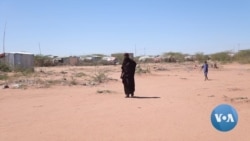U.N. agencies say that large-scale, sustained humanitarian assistance can prevent Somalia’s looming famine from turning into a full-blown disaster in the coming months.
Thanks to generous international support this year, famine in Somalia has been delayed. But the threat of mass starvation in 2023 remains due to a fifth year of consecutive drought, skyrocketing food prices, and intensifying conflict.
A recent U.N. food assessment found the number of people facing acute food insecurity could rise to 8.3 million by April and the number of Somalis facing catastrophic food insecurity could increase to more than 700,000 by June. It warned some areas will face outright famine if humanitarian assistance is not scaled up and sustained.
Etienne Peterschmitt is the U.N. Food and Agriculture Organization representative in Somalia. Speaking from the capital Mogadishu, he says the specter of Somalia’s 2011 famine continues to haunt aid agencies and what happened then must not be repeated now.
“Just to recall that in 2011, we have mentioned that in several reports, and we keep highlighting that fact is that by the time famine was declared, half of the people who actually died of famine had already died,” Peterschmitt said.
More than a quarter million people died of famine that year, half of them children under age five.
FAO reports rural communities are currently among those at greatest risk and in greatest need. The unprecedented drought, it notes, has forced entire pastoral, agropastoral, and farming communities to leave home and seek humanitarian aid in crowded displacement camps in towns.
Peterschmitt says their ability to stave off hunger and famine depends on the survival of their herds and ability to grow crops.
“Their children’s nutrition, and we mentioned that before, is directly linked to the health and productivity of their animals,” Peterschmitt said. "Unable to produce milk, those animals have been dying at a skyrocketing rate for the last year…Of great concern is the approximately 1.8 million children who are likely to be malnourished.”
Earlier projections of famine so far have been averted because humanitarian assistance has covered much of the most basic needs. U.N. agencies say this aid must continue and be increased.
On December 1, the United Nations launched a record $51.5 billion humanitarian response plan to assist 69 countries in 2023. The plan asks for $2.2 billion in support of 7.6 million people in Somalia.







